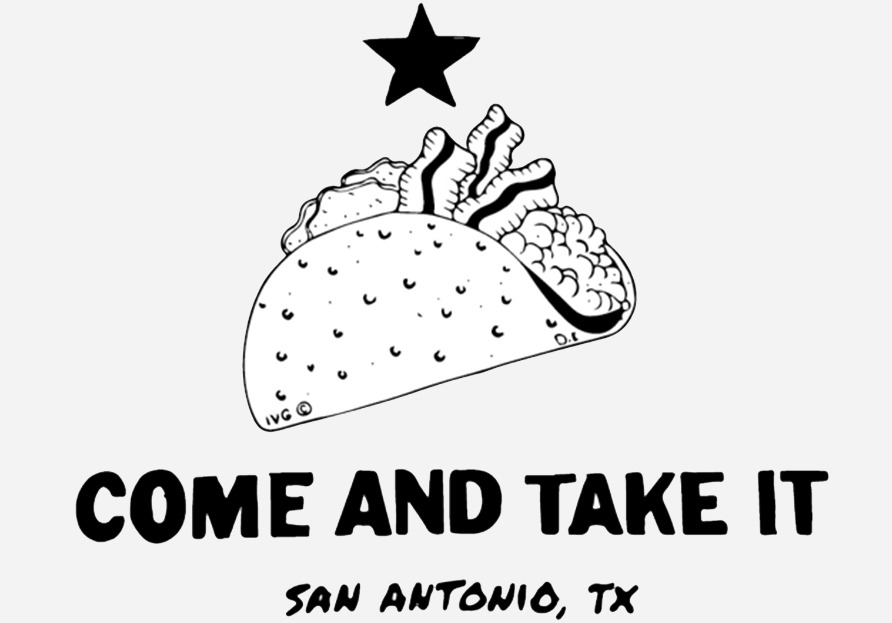photo: Dzrt Lizard “Come and Take it” shirt
In early March, war broke out between San Antonio and Austin over the culinary treasure that some refer to as the “breakfast taco” and natives of its birthplace in deep South Texas call the taquito. The dispute, instigated by an ill-informed online article by a New York food writer declaring Austin the home of the “breakfast taco,” inspired sharp words from San Antonio, more civic participation than is often seen at the polls, an online petition, and a pair of all-too-eager mayors ready to play to the cameras. Last week, at the launch of the SXSW conference in Austin, the mayors declared a truce in the Taco War of 2016 by sharing their favorite tortilla-wrapped warm goodness at a Taco Summit in the Texas Capitol.
The dispute over the taquito—whose incarnations include combinations of egg, potato, bacon, beans, and other protein bombs that have seen generations of the working class through the day—caused more than its share of eye rolls, including mine. After all, Texas has no shortage of political and economic troubles to worry about, along with a recent track record of producing presidential candidates who terrify the country.
Still, it’s an audacious notion that Austin, with its shameful record of redlining and segregation, where city-backed gentrification is decimating the neighborhoods where the taquito is associated with home, not hipsters, would challenge its southern neighbor in laying claim to the taco. (Indeed, the beloved taco championed by Austin is a creation for the trendy and the techies.) And, the sight of the mayors, neither of whom rode into office as the choice of Latino voters, and who represent two of the most segregated cities in the country, claiming a culinary mainstay of an ethnic group they failed to appeal to reeked of the cultural appropriation and erasure of Mexican-Americans on which Texas and the West was built.
Clearly, while the taco finds its roots in Mexican culture, cultural appropriation is not unique to Latinos. But when applied to Latinos, cultural, ahem, adoption has worked in tandem with erasure. Ever since the frontier days, when the swath of (what is now) South Texas, where flour tortillas were first toasted on warm comales (griddles) and a people’s homeland was regarded as open land for the taking, Mexican and Mexican-American culture have contributed to the mantle of Americanness, even while being regarded as “foreign” or “newly arrived.”
Indeed, upon closer inspection, the taco dispute illustrates the broader and more deeply entrenched and often ignored nativist tendencies that rumble along at low levels—low levels, that is, until men in camouflage begin screaming at asylum seekers on the nation’s southern border. Or, until some of the same men move on to the occupation of government property (as they did recently in Oregon). Or until presidential candidates begin pounding the drum of border security by resorting to racist characterizations.
“A lot of the right-wing politics is around erasure of people they have been afraid of,” says Richard Flores, a professor of anthropology at the University of Texas at Austin and author of Remembering the Alamo. “The border rhetoric is not about the border; the more you marginalize the outsider the more you marginalize those who are already here.”
The irony, of course, is the cowboy image has its origins in the Mexican vaquero, whose style and ranching techniques were adopted—appropriated—by incoming whites as part of the timeless dynamic of the West of adopt and destroy.
In declaring war on San Antonio, Austin mayor Steve Adler seized on the attitudes inspired by Manifest Destiny and embraced by generations of political elites who have laid claim to the land, rights, and culture of Mexican-Americans to serve their own political, social, and cultural wants and needs. Standing before a gathering of student volunteers, Adler said, “Austin may not have invented breakfast tacos but, by God, Austin made them better.” He then told his young taco war recruits, “we march to San Antonio at dawn, right after we get some tacos.”
The claim of improving upon the taco —which was born perfect—is (apart from being preposterous) a direct descendent from the genesis story that the land that became Texas was “empty” and begging for improvement, as T.R. Fehrenbach wrote in his seminal book Lone Star. In the 19th century, Texas lured whites from other parts of the country to homestead the land that once belonged to Tejanos, in the spirit of “improvement,” an early form of gentrification.
That legacy is seen today in the angry faces of the men involved in seizing the Malheur National Wildlife Refuge in Oregon. With their cowboy hats and blue jeans, they appeared to represent the sacred image of the American cowboy, which explains, in part, why the press seemed to agonize over whether to call them terrorists, militants, occupiers, or the more benign term, activists. After all, their appearance fit with the American image of the frontier, wrought from violence and confrontation with “savages.”
Before turning on the federal government, some of their ranks had descended on the Rio Grande Valley to scream at incoming Central American children, many of whom qualified for asylum, under the guise of protectors of the border from “invaders.”
On the border and in Oregon they fit within the mythical West. The irony, of course, is the cowboy image has its origins in the Mexican vaquero, whose style and ranching techniques were adopted—appropriated—by incoming whites as part of the timeless dynamic of the West of adopt and destroy. Folklorist Américo Paredes writes that the word “‘cowboy’ began as the name of the Anglo cattle thieves who raided the Nueces-Rio Grande area in the late 1830s and who, revolvers in hand, began the dispossession of the Mexicans on the north bank of the Rio Grande.”
As in the declaration of the Taco War in Austin with its language of improvement, Anglo forefathers formed the storm troopers of western expansion, urged on by government officials. Steven Woodworth, the author of Manifest Realities: America’s Expansion and the Road to the Civil War, says the prevailing vision for the country was one of “good citizens” who could “settle” the West. The government’s philosophy envisioned “sturdy farmers” and “good citizens” who take good care of the land and do the things that good citizens do: plant crops, build a house, and build barns. In other words, participate in the “improvement.”
The “cowboys” who turned on the federal government in Oregon, the heirs of that manifest philosophy, were denouncing the very institution that had created them, after it acquired the western lands through war, wealth, violence, and dispossession. Their image, the one that resonates with most Americans, once took on mythical status thanks to the cultural elites on the East Coast who turned out the dime novels and illustrations that glorified their image as the American ideal. And so it was unsurprising that the clumsy words of a New York writer would trigger the Taco War of 2016; it simply fit within a deeply ingrained tradition of codifying the transfer of cultural ownership by a select elite.
Just as in the 19th century, domination has been met with resistance. This time the counter-attack targets the very symbols that have defined Texas and the West. I recently came across one: a T-shirt design by San Antonio artist Ivette Snell, which draws from the slogan adopted by Anglo Texian rebels at the onset of their war against Mexico. In 1835, the rebels who went to battle against Mexico to prevent its soldiers from recovering their cannon fashioned their war flag with an image of a cannon—and the motto now embraced by right-wing no-government types: “Come and Take It.” But in its new incarnation, instead of a cannon in the center, the artist from San Antonio inserted a taco.
Michelle García is a native South Texan, currently working a book about myth, the border, and manhood.







Looking forward to your book.
College friend of Felipe
Starr County Native
‘Folklorist Américo Paredes writes that the word “‘cowboy’ began as the name of the Anglo cattle thieves who raided the Nueces-Rio Grande area in the late 1830s and who, revolvers in hand, began the dispossession of the Mexicans on the north bank of the Rio Grande.’ Given where I live, this is an interesting piece of traditional belief. My little town in far west Texas is bounded by ranch land and cowboys.
The label “cowboy” applied to cattle and horse thieves well up through the 19th and into the early 20th century. Histories of Arizona and New Mexico Territories are awash with their misdeeds, including robbery and murder. Now there’s an idol for you.